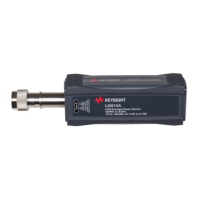General Operating Information 2
Keysight 2050/60 X-Series User’s Guide 59
Table 2-2 Power meter settings in the Normal mode description
Item Description
Presets – Preset the instrument to its default values or values appropriate for measuring the communications format.
The data stored in the correction (FDO, gamma, and S-parameter) tables, the selected correction table, and the zeroing and
calibration data are not affected by a preset.
– Perform a system reset.
Channel Setup – Set the channel mode to the Normal or Average Only mode.
– Set the measurement frequency.
– Set the channel offset which is applied to the measured power prior to any mathematical functions. Refer to “Simplified
Measurement Path” on page 70.
– Set the automatic or manual measurement average mode. The number of readings averaged can range from 1 to 1024.
Increasing the value of the measurement average reduces measurement noise, but increases measurement time. The
measurement average filter can also be reset. Refer to “Typical Averaged Readings” on page 71.
Calibration Auto-calibrate the 2050/60 X-Series without having to connect it to a power reference, or auto-zero the 2050/60 X-Series
internally or externally.
Internal zeroing can be performed with or without the RF/microwave signal present, while external zeroing must be performed
without any RF/microwave signal present.
Measurement – Run/stop the measurement.
– Set the logarithmic (dBm) or linear (Watt) measurement unit.
– Set the measurement offset factor. The 2050/60 X-Series corrects every measurement by this factor to compensate for the
gain/loss.
– Enable the relative mode, which computes the measurement result relative (as a ratio) to a reference value. When enabled,
the reference value can be set using the <Rel> control. The relative reading is displayed in either dB or %.
– Enable the difference or ratio measurement, or disable all operations between feed 1 and feed 2.
– Configure the gate and acquired measurement type for the feed.
Trigger Setup – Set the single, free run, or continuous trigger mode. The free run mode does not allow any trigger setup.
– Set the trigger source to an internal or external source.
– Enable auto level or manually set the trigger level for the internal trigger source.
– Set the delay time to be applied between the trigger event and all the gate start times. This allows you to time-shift all the
gates by the same amount with one setting change.
– Select the positive or negative slope type to determine if the trigger event is recognized on the rising or falling edge of a
signal respectively.
– Set the holdoff time to disable the trigger mechanism after a trigger event occurs.
– Set the hysteresis to help generate a more stable trigger by preventing triggering unless the RF power level achieves the
trigger level and the additional hysteresis value. It can be applied to both rising and falling edge trigger generation.
Hysteresis is only available for the internal trigger source and manual trigger level.
– Set the qualification value.

